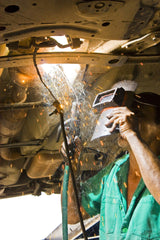Auto body shops and garages put workers at risk
Posted by Julia G on
Unless you live in the urban jungle, cars have become a necessity in North America - back in 2014, there were more than 260 million registered passenger vehicles in the United States. 
When these vehicles need repairs, car owners often go to independently owned auto body shops or garages.
These businesses can employ from one to up to 100 workers, and the nature of these small businesses means the level of risk may vary a lot from one shop to the next.
Chemical exposures a real risk
The nature of car repairs dictates that mechanics and auto body shop workers are at an increased risk of exposure to toxic substances.
Their work includes handling and possible exposure to solvents, paints, metal pigments, asbestos, dusts, synthetic plastic dusts, synthetic resins in body fillers and finishes, cleaners or dyes for leather and vinyl interiors or vehicle tops, lubricants as well as greases, fluids, antifreeze, and detergents with solvent cleaners.
The NCI National Bladder Cancer Study also warned of aromatic amines, paint thinners, betanaphthylamine, rubber and rubber products, petroleum and its products, coal gas, chlorinated compounds, nitro or nitroso compounds, listed metals and sulpha-containing compounds.
The list also includes gasoline as well as diesel fuel and additives, engine exhaust, lead from metalworking, and more. The most toxic chemicals include toluene, benzene and xylene.
Health effects from toxic exposures
Most of the chemicals used in auto body shops and garages tend to be irritants or central nervous system depressants. Some even enter into the bloodstream for toxic effects. 
Studies have shown that automobile mechanics and repair workers are at higher risk for lung cancer and cancer of the trachea, bronchus and lung -- the risk is especially high when there was known or suspected exposure to asbestos.
This risk applies to workers handling brakes or clutch assemblies, among others. For automobile brake linings containing asbestos, the asbestos content tends to be about 55%. For trucks, it is about 33%.
While there have been quite a few asbestos substitutes on the market because of the health concerns, asbestos-containing materials are still widespread, meaning a mechanic can never be sure whether exposure occurred or not.
Studies have also revealed a higher risk for leukemia, cancers of the oral cavity, bladder, rectum and lymphatic tissues. Researchers suspect benzene exposure in many of these.
How to stay healthy and safe at work
In North America, health and safety laws are supposed to protect workers from many exposures and their consequences.
These laws require employers to identify and educate workers about possible risks.
Employers are responsible for:
- Safe handling and use of toxic substances
- Proper waste disposal
- Establishing procedures to follow when materials are spilled or leaking
- Putting in place emergency and first aid procedures
- Making certain chemicals off-limits to workers whose medical conditions may worsen with exposure
- Having up-to-date MSDS (material safety data sheets) available for all potentially harmful chemicals
- Using good ventilation, air cleaning systems or other ways to minimize exposure. For example, safety equipment such as goggles, gloves and respirators, air cleaners with source capture or vented paint rooms.
Employers should always aim to replace toxic substances with safer ones.
For example, most degreasing solvents are irritants and may become health hazards with prolonged use. Experts suggest using terpenes for degreasing - they are biodegradable and made from the white pulpy part of citrus fruit rinds, but they still do a great job at degreasing, even when diluted.
Find more information on auto body shop air cleaners.
Share this post
- Tags: auto body shop, chemicals, garage, health and safety, OSHA, solvents, workplace
